Documents: Go to download!
User Manual
- Owner's manual - (English)
- Warranty certificate (ALL) (pdf) - (English)
- Energy Label - (English)
- product information sheet - (English)
- Brochure - (English)
- 3D file - (English)
- Technical sheet - (English)
User manual of Smeg PRIMASCB9X (50 pages)
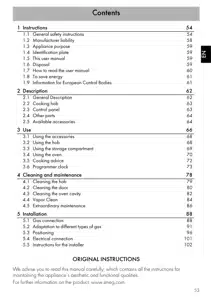
User Gudie Smeg PRIMASCB9N Gas Hob
Table of contents
- Instructions
- General safety instructions
- Manufacturer liability
- Appliance purpose
- Identification plate
- This user manual
- Disposal
- How to read the user manual
- To save energy
- Information for European Control Bodies
- Description
- General Description
- Cooking hob
- Control panel
- Other parts
- Available accessories
- Use
- Using the accessories
- Using the hob
- Using the storage compartment
- Using the oven
- Cooking advice
- Programmer clock
- Cleaning and maintenance
- Cleaning the hob
- Cleaning the door
- Cleaning the oven cavity
- Vapor Clean
- Extraordinary maintenance
- Installation
- Gas connection
- Adaptation to different types of gas
- Positioning
- Electrical connection
- Instructions for the installer
Appliance purpose
- This appliance is intended for cooking food in the home environment. Every other use is considered inappropriate.
- The appliance is not designed to operate with external timers or with remote-control systems.
- Identification plate
- The identification plate bears the technical data, serial number and brand name of the appliance. Do not remove the identification plate for any reason.
- This user manual
- This user manual is an integral part of the appliance and must therefore be kept in its entirety and within the user’s reach for the whole working life of the appliance.
- Read this user manual carefully before using the appliance.
- To save energy
- Only preheat the appliance if the recipe requires you to do so.
- Unless otherwise indicated on the package, defrost frozen foods before placing them in the oven.
- When cooking several types of food it is recommended to cook the foods one after the other to make the best use of the already hot oven.
- Use dark metal moulds: They help to absorb the heat better.
- Remove all trays and racks which are not required during cooking.
- Stop cooking a few minutes before the time normally used.
- Cooking will continue for the remaining minutes with the heat which has accumulated inside the oven.
- Reduce any opening of the door to a minimum to avoid heat dispersal.
- Keep the inside of the oven clean at all times.
Light sources
• This appliance contains userreplaceable light sources.

• The light sources contained in the appliance are declared suitable for operation at ambient temperature ≥300°C and intended for use in high temperature applications such as ovens.
• This appliance contains light sources of efficiency class "G".
General Description

Temperature knob
- This knob allows you to select the cooking temperature. Turn the knob clockwise to the required value, between the minimum and maximum setting.
Indicator light
- The indicator light comes on to indicate that the oven is heating up. It turns off as soon as it reaches the set temperature. It flashes regularly to indicate that the temperature set inside the oven is kept constant.
Programmer clock
- For displaying the current time, setting programmed cooking operations and the minute minder timer.
Function knob
- The oven’s various functions are suitable for different cooking modes. After selecting the required function, set the cooking temperature using the temperature knob.
Hob burner knobs
- Useful for lighting and adjusting the hob burners.
- Press and turn the knobs anti-clockwise to the value to light the relative burners.
- Turn the knobs to the zone between the maximum and minimum setting to adjust the flame.
- Return the knobs to the position to turn off the burners.
Shelves
- The appliance features shelves to position trays and racks at different heights. The insertion heights are indicated from the bottom upwards (see 2.1 General
Description
- Interior lighting
- The appliance interior lighting comes on:
- When the door is opened
- When any function is selected, apart from the function.
Cooling fan
- The fan cools the oven and comes into operation during cooking. The fan causes a steady outflow of air that exits from the rear of the appliance and which may continue
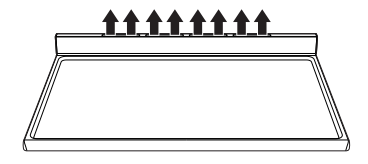
- A gas leak can cause an explosion.
- If you smell gas or there are faults in the gas system:
- Immediately turn off the gas supply or close the valve on the gas cylinder.
- Extinguish all open flames and cigarettes.
- Do not turn on power switches or appliances and do not remove plugs from power sockets. Do not use phones or mobile phones inside the building.
- Open the window in order to ventilate the room.
- Call customer assistance services or your gas supplier.
Malfunctions
- Any of the following indicate a malfunction and you should contact a service centre:
- Yellowing of the burner plate.
- Damage to kitchen utensils.
- The burners do not ignite properly.
- It is difficult to keep the burners lit.
- The burners go out when the appliance is in use.
- It is difficult to turn the gas valves.
- If the appliance does not work properly, contact your local Authorised Service
Centre.
- First use
- Remove any protective film from the outside or inside of the appliance, including accessories.
- Remove any labels (apart from the technical data plate) from the accessories and from the oven cavity.
- Remove and wash all the appliance's accessories (see 4 Cleaning and maintenance).
- Heat the empty oven at the maximum temperature to burn off any residues left by the manufacturing process.
- Ring reducers
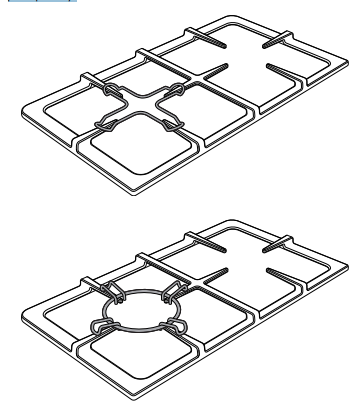
- The ring reducers have to be placed on the hob grids. Make sure they are placed properly
- For better burner efficiency and to minimise gas consumption, use pans with lids and of suitable size for the burner, so that the flames do not reach up the sides of the pan.
- Once the contents come to the boil, turn down the flame far enough to ensure that the liquid does not boil over
- Using the storage compartment The storage compartment is at the bottom of the cooker. To open it, pull the handle towards you. It can be used to store cookware or metallic objects necessary when using the appliance.
Static
- As the heat comes from above and below at the same time, this system is particularly suitable for certain types of food.
- Traditional cooking, also known as static cooking, is suitable for cooking just one dish at a time. Perfect for all types of roasts, bread and cakes and in any case particularly suitable for fatty meats such as goose and duck.
Fan + lower element
- The combination of the fan with just the lower heating element allows cooking to be completed more rapidly.
- This system is recommended for sterilising or for finishing off the cooking of foods which are already well-cooked on the surface, but not inside, which therefore need a little more heat.
Perfect for any type of food.
- In pyrolytic models, the special defrost and proving functions are brought together under the same function.
Small grill
- Using only the heat released from the central element, this function allows you to grill small portions of meat and fish for making kebabs, toasted sandwiches and any types of grilled vegetable side dishes.
Grill
- The heat coming from the grill element gives perfect grilling results above all for thin and medium thickness meat and, in combination with the rotisserie (where fitted), gives the food an even browning at the end of cooking. Perfect for sausages, spare ribs and bacon.
- This function enables large quantities of food, particularly meat, to be grilled evenly
Fan with grill
- The air produced by the fan softens the strong heatwave generated by the grill, grilling perfectly even very thick foods. Perfect for large cuts of meat (e.g. shin of pork).
Fan assisted
- The operation of the fan, combined with traditional cooking, ensures consistent cooking even with complex recipes.
- Perfect for biscuits and cakes, even when simultaneously cooked on several levels. (For multiple-level cooking, we recommend using the 2nd and th shelves.)
Fan with circulaire
- The combination of the fan and the circulaire heating element incorporated in the rear of the oven) allows you to cook different foods on several levels, as long as they need the same temperatures and same type of cooking.
- Hot air circulation ensures instant and even distribution of heat. It will be possible, for instance, to cook fish, vegetables and biscuits simultaneously (on different levels) without odours and flavours mingling.
Eco
- This function is particularly suitable for cooking on a single shelf with low energy consumption.
- It is recommended for all types of food, excluding those that can create a lot of humidity (such as vegetables).
- To obtain maximum energy savings and reduce cooking times, it is recommended to place food in the oven without preheating.
Advice for cooking meat
- Cooking times vary according to the thickness and quality of the food and to consumer taste.
- Use a meat thermometer when roasting meat, or simply press on the roast with a spoon. If it is hard, it is ready; If not, it needs another few minutes cooking.
- Advice for cooking with the Grill and the
Fan with grill
- Meat can be grilled even when it is put into the cold oven or into the preheated oven if you wish to change the effect of the cooking.
- With the Fan with grill function, we recommend that you preheat the oven before grilling.
- We recommend placing the food at the centre of the rack.
- With the Grill function, we recommend that you turn the temperature knob to the maximum value near the symbol to optimise cooking.
- Foods should be seasoned before cooking. Foods should also be coated with oil or melted butter before cooking.
- Use the oven tray on the first bottom shelf to collect liquids produced by grilling.
Advice for cooking desserts/pastries and biscuits
- Use dark metal moulds: They help to absorb the heat better.
- The temperature and the cooking time depend on the quality and consistency of the dough.
- To check whether the dessert is cooked right through: At the end of the cooking time, put a toothpick into the highest point of the dessert. If the dough does not stick to the toothpick, the dessert is cooked.
- If the dessert collapses when it comes out of the oven, on the next occasion reduce the set temperature by about
- C, selecting a longer cooking time if necessary.
- While cooking desserts or vegetables, excessive condensation may form on the glass. In order to avoid this, open the door very carefully a couple of times while cooking
Modifying the set data
- Press the clock key .
- Use the value increase and value decrease keys to set the number of minutes required.
- Deleting the set data
- Press the clock key .
- Hold down the value increase and value decrease keys at the same time.
- Then switch off the oven manually if cooking is in progress.
- Selecting the buzzer
- The buzzer can have 3 tones.
- Hold down the value increase and value decrease keys at the same time.
- Press the clock key .
- Press the value decrease key to select a different buzzer tone
Cleaning and maintenance
Ordinary daily cleaning
- Always use specific products only that do not contain abrasives or chlorine-based acids.
- Pour the product onto a damp cloth and wipe the surface, rinse thoroughly and dry with a soft cloth or a microfibre cloth.
Food stains or residues
- Do not use steel sponges and sharp scrapers, as they will damage the surfaces.
- Use normal, non-abrasive products and a wooden or plastic tool, if necessary. Rinse thoroughly and dry with a soft cloth or a microfibre cloth.
- Do not allow residues of sugary foods (such as jam) to set inside the oven. If left to set for too long, they might damage the enamel lining of the oven.
Cooking hob grids
- Remove the grids and clean them in lukewarm water and non-abrasive detergent. Make sure to remove any encrustations. Dry them thoroughly and return them to the hob.
Flame-spreader crowns and burner caps
- For easier cleaning, the flame-spreader crowns and the burner caps can be removed. Wash them in hot water and nonabrasive detergent.
- Carefully remove any encrustation, then wait until they are perfectly dry. Refit the flame-spreader crowns making sure that they are correctly positioned in their housings with their respective burner caps.
Igniters and thermocouples
- For correct operation the igniters and thermocouples must always be perfectly clean. Check them frequently and clean them with a damp cloth if necessary.
- Remove any dry residues with a wooden toothpick or a needle.
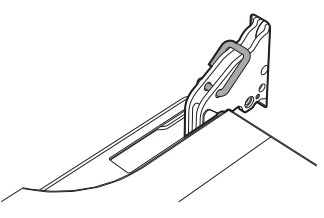
Removing the door
- For easier cleaning, the door can be removed and placed on a canvas. To remove the door proceed as follows:
- Open the door completely and insert two pins into the holes on the hinges indicated in the figure.
- Grasp the door on both sides with both hands, lift it forming an angle of around 30° and remove it. 3. To reassemble the door, put the hinges in the relevant slots in the oven, making sure that grooved sections A are resting completely in the slots. Lower the door and once it is in place remove the pins from the holes in the hinges.
Cleaning the door glazing
- The glass in the door should always be kept thoroughly clean. Use absorbent kitchen roll. In case of stubborn dirt, wash with a damp sponge and an ordinary detergent.
- Extract the internal glass pane from the front strip (2) to remove it from the door.
- Remove the intermediate glass pane by lifting it upwards.
- Clean the external glass pane and the panes removed previously. Use absorbent kitchen roll. In case of stubborn dirt, wash with a damp sponge and neutral detergent.
- When you have finished cleaning, reinsert the intermediate glass pane in its housing in the door.
- To reposition the internal glass pane, slide the upper part into the door strip and insert the two rear pins into their seats by pressing lightly
Cleaning the oven cavity
- In order to keep your oven in the best possible condition, clean it regularly after letting it cool down.
- Avoid letting food residue dry inside the oven cavity, as this could damage the enamel. Take out all removable parts before cleaning. For easier cleaning, we recommend removing:
- The door
- The rack/tray support frames
- The seal.
Removing racks/trays support frames
- Removing the rack/tray support frames enables the sides to be cleaned more easily. To remove the rack/tray support frames:
- Pull the frame towards the inside of the oven to unhook it from its groove A, then slide it out of the seats B at the back. When cleaning is complete, repeat the above procedures to put the rack/tray support frames back in.
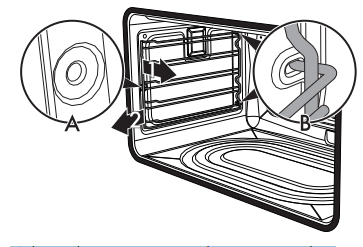
- Removing the side self-cleaning panels and rack/tray support frames (on some models only) Removing the side self-cleaning panels and the rack/tray support frames enables the sides to be cleaned more easily. To remove the self-cleaning panels and rack/tray support frames:
- Pull the frame towards the inside of the oven to unhook it from its groove A, then slide it out of the seats B at the back. The side self-cleaning panel is attached to the rack/tray support frame'
Regeneration of self-cleaning panels catalytic cycle) (on some models only)
- The regeneration cycle of the self-cleaning panels is a cleaning method through heating suitable for removing small grease residues, not sugar-based ones.
- Clean the base and the upper section first with a microfibre cloth soaked in water and neutral washing up liquid.
Rinse thoroughly.
- Set a regeneration cycle by selecting a fan assisted function at the maximum temperature for one hour.
- If the panels are particularly dirty after the regeneration cycle, remove them and wash them with neutral washing up liquid. Rinse and dry them.
- Put the panels back in the oven and set a fan assisted function at a temperature of
- C for one hour, in order to ensure that they are thoroughly dry.
Preliminary operations
- Before starting the Vapor Clean function:
- Completely remove all accessories from inside the oven.
- During the assisted cleaning cycle, wash the self-cleaning panels which were previously removed separately with warm water and a small amount of detergent.

Vapor Clean setting
- Turn the function knob to the symbol and the temperature knob to the symbol .
- Set a cooking time of 18 minutes using the programmer clock.
- The Vapor Clean cycle starts a few seconds after the last press on the programmer clock keys.
- At the end of the Vapor Clean cycle, the timer will deactivate the oven heating elements, the buzzer will start to sound and the numbers on the programmer clock dial will flash.
End of the Vapor Clean cycle
- Open the door and wipe away the less stubborn dirt with a microfibre cloth.
- Use an anti-scratch sponge with brass filaments on tougher encrustations.
- In case of grease residues use specific oven cleaning products.
- Remove the water left inside the oven.
- For improved hygiene and to avoid food being affected by any unpleasant odours, we recommend that the oven is dried using a fan assisted function at 160 °C for approximately 10 minutes.
Installation
- General information Connection to the gas mains can be made using a continuous wall steel hose in compliance with the guidelines established by the standards in force.
- The appliance is preset for natural gas G20 (2H) at a pressure of 20 mbar. For supplying it with other types of gas, see chapter “5.2 Adaptation to different types of gas”. The gas inlet connection is threaded ½” external gas (ISO 228-1).
Connection with a rubber hose
Verify that all following conditions are met: the hose is attached to the hose connector with safety clamps; no part of the hose is in contact with hot walls (max. 50 °C);
- the hose is not under traction or tension and has no kinks or twists;
- the hose is not in contact with sharp objects or sharp corners;
- if the hose is not perfectly airtight and leaks gas, do not try to repair it;
- replace it with a new hose; verify that the hose is not past its expiry date (serigraphed on the hose itself).
Connection with a steel hose
- Make the connection to the gas mains using a continuous wall steel hose whose specifications comply with the applicable standard.
- Carefully screw the connector 3 to the gas connector 1 of the appliance, placing the seal 2 between them
Connection to LPG
- Use a pressure regulator and make the connection on the gas cylinder following the guidelines set out in the standards in force.
- The supply pressure must comply with the values indicated in the table “Gas types and Countries”.
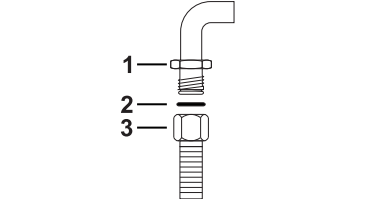
Assembling the upstand
- The upstand must always be positioned and secured correctly on the appliance.
- Unscrew the 2 nuts B on the back of the worktop.
- Position the upstand above the worktop, taking care to align the pins C with the holes D.
- Secure the upstand to the worktop by tightening the screws A
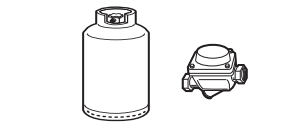
Fixed connection
- Fit the power line with an omnipolar circuit breaker in compliance with installation regulations. The circuit breaker should be located near the appliance and in an easily reachable position.
- Connection with plug and socket
- Make sure that the plug and socket are of the same type.
- Avoid using adapters, gang sockets or extensions as these could cause overheating and a risk of burns
Instructions for the installer
- The plug must be accessible after installation. Do not bend or trap the power cable.
- The appliance must be installed according to the installation diagrams.
- Do not try to unscrew or force the threaded elbow of the fitting. You may damage this part of the appliance, which may void the manufacturer’s warranty.
- Use soap and water to check for gas leaks on all connections. DO NOT use naked flames when looking for leaks.
- Turn on all the burners separately and at then all together to make sure that the gas valve, burner and ignition are working properly.
- Turn the burner knobs to the minimum position and check that the flame is stable for each individual burner and all the burners together.
- If the appliance does not work correctly after having carried out all the checks, contact your local Authorised Service
See other models: PRIMASCB9N CPF9GMX1 CPF9GMWH1 CPF9GMOR1 CPF9GMOG1
